Kentucky Pesticide Safety Education Program

Questions?
Contact
Dr. Ric Bessin
Dept. of Entomology
University of Kentucky
859-257-7450
rbessin@email.uky.edu
Transporting Pesticides
Every pesticide applicator should understand the hazards of transporting pesticides and the procedures for minimizing those risks.
Pesticides are moved by manufacturers to distributors, from retailers to end users, and from storage sites to job sites. Transportation-related accidents can happen at any point along the way. The first line of defense is recognizing how to prevent these transportation mishaps. When accidents occur, the timing of your response could determine the size of the spill.
[return]
The Transportation Vehicle
Transport vehicles should be in good mechanical condition. Make sure brakes, tires, and steering work properly. Repair all fluid leaks before putting a truck on the road or leaving the job site. Regularly inspect application equipment to be transported and used. Inspect hoses under pressure for wear and cracks and hose clamps for rust. Always carry supplies and replacement parts to make emergency repairs if a leak should develop while going to and from the job site.

Never carry liquid pesticides in the passenger area because spilled chemicals may cause harmful fumes that can be inhaled. A pesticide spilled in the cab is difficult to remove and may lead to long-term inhalation exposure.
Keep pesticide containers in the original shipping box. Depending on the material, many of these boxes meet the U.S. Department of Transportation (DOT) packaging standards to give added protection to the contents. Try to carry a minimum amount of pesticide products on a vehicle at any one time.
Secure and protect pesticide containers against punctures and impacts from items packed closely together. Enclosed cargo boxes provide extra security from curious children, thieves, or vandals. Never stack pesticide containers higher than the sides of the vehicle. Make sure flatbed trucks have tie-down rings or racks to simplify the job of securing the load.
The Vehicle Operator
The driver or owner of the company is accountable for injuries to people and any pesticide release into the environment. The vehicle operator (driver) is the first person who can contain a spill and prevent it from spreading. By the time first responders arrive on the scene, the spill may already be contained. Therefore, it is important that the driver know basic emergency response procedures to contain the spill, company guidelines, and who will notify local, state, and federal authorities. A later chapter, Emergency or Incident Response, explains in detail how to respond to a fire, spill, or leak involving pesticides.
Some drivers transporting pesticides regulated as hazardous materials will be required to follow DOT regulations regarding commercial driver licenses, placarding, shipping papers, and annual inspections.
Other Safety Precautions
Always carry product labels and Safety Data Sheets (SDSs) when transporting pesticides on highways. The SDS contains critical information for the driver and emergency responders after a pesticide spill. It lists steps to safely deal with the spill, including the personal protective equipment (PPE) to use, whether the spill carries an inhalation or explosion risk, decontamination procedures, and emergency telephone numbers. Have the labels and SDSs well organized and alphabetically arranged by product name to allow quick access in the event of a spill.
Always carry a spill kit with the items you will need to handle a spill during transport. (The contents of a spill kit are discussed later.) Inspect containers to ensure they have legible and attached labels, tight closures, and pesticide-free outside surfaces. Secure application equipment (such as hand sprayers, backpack sprayers, and spreaders) during transport.
Protect pesticides from extreme temperature and moisture during transit. Depending on the pesticide, either extremely low or extremely high temperatures can alter the stability of certain pesticide formulations.
Vehicle Placards
DOT requires diamond-shaped signs called placards to be placed on vehicles that transport certain types and quantities of hazardous materials. Most distributors will give you any required placards to place on your transportation vehicle. Placards provide emergency responders with the information necessary to quickly assess an accident situation.
If you ship or transport materials in quantities that require placards, you must develop and implement a transportation security plan.
Vehicles must be placarded when transporting pesticides:
- Bearing a DOT poison label.
- In containers larger than 119 gallons.
- In quantities greater than 1,000 pounds.
The security plan must include measures to prevent unauthorized access, a security check of employees who pick up and transport placarded hazardous materials, and the intended route of travel. For further details on the transportation security plan, contact the Hazardous Materials Information Center.
[return]
Storage of Pesticides in Buildings
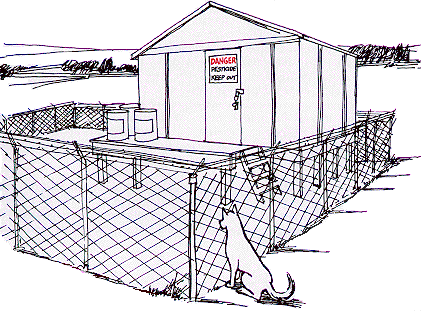
Although existing buildings are often used for pesticide storage, it is best to have a separate storage facility for pesticides, fertilizers and other similar products. Storing pesticides separately gives emergency response crews more options in dealing with fires and spills. Keeping equipment, employees, and records away from pesticides is always recommended where possible.
A well-designed pesticide storage site:
- Limits access.
- Permits better inventory control.
- Protects people from exposure.
- Reduces the chance of environmental contamination.
- Prevents damage to pesticides from temperature extremes and excess moisture.
- Safeguards pesticides from theft, vandalism, and unauthorized use.
- Allows fire departments to know the location of products.
Secure the Site
Whether the designated storage area is a cabinet, an entire room, or a separate building, keep it locked when not in use. Post warning signs on doors and windows to alert others that pesticides are stored inside.
Prevent Water Damage
Pesticide storage facilities should not be located in a flood zone. Carefully consider soil and land surface characteristics when selecting a storage site to prevent contamination of surface water or groundwater. Do not locate the storage facility near a stream likely to flood or where runoff water flows toward the facility. If flooding is likely, consider building dikes around the storage facility. Work with local zoning and building code professionals to determine how best to protect the environment if high water were to enter the storage facility.
Consider storing pesticides on a raised pallet or on shelves to prevent high water from damaging pesticide containers or flowing water from moving them offsite. Water or excess moisture may damage pesticide containers and their contents and cause:
- Metal containers to rust.
- Paper and cardboard containers to split or crumble.
- Pesticide labeling to peel, smear, or otherwise become unreadable.
- Dry pesticides to clump, degrade, or dissolve.
- Slow-release products to release their ingredients.
Control the Temperature
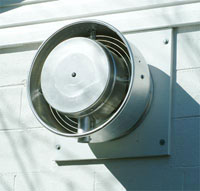
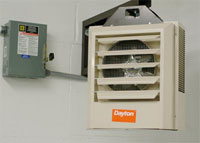
Provide Adequate Lighting
Be sure the pesticide storage facility is well-lighted. Pesticide handlers entering the building must be able to read the product labels and determine whether containers are leaking.
Use Nonporous Materials
Use cement or other impervious materials for flooring to retain the spilled material on the surface. Such surfaces are easy to clean and decontaminate in the event of a release. A floor that slopes into a sump helps collect and contain the spill. Consider using shelving and pallets made of nonabsorbent materials, such as plastic or metal, for the same reasons as impervious floors.
Maintain the Storage Site
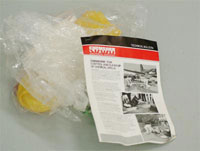
Keep Labels Legible
Store pesticide containers with the labels in plain sight. Costly errors may result if the wrong pesticide is chosen. Be sure labels are always legible. If the label is destroyed or damaged, immediately mark the container with some basic labeling information, such as the trade name, the EPA registration number, signal word, and use classification. Go online to find a product replacement label or get a new label from the manufacturer.
[return]
Store Pesticide Containers Safely
Store pesticides in their original containers or, if allowed by state law, in a properly labeled service container. Never use any other container to store a product. Besides being illegal, serious injury may result when using food containers, such as milk jugs or soft drink bottles. Children will associate the shape, size, and color of the container with its usual contents. Never use a pesticide product from an unmarked or unlabeled container unless you are certain what it is. Guessing wrong can cause serious damage at the application site.
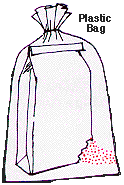
Keep pesticide containers securely closed when not in use. Dry pesticide formulations can clump together under high humidity. Consider placing partially used bags of wettable and soluble powders, dry flowables, dusts, and granules in a plastic trash bag or tub with a cover to reduce clumping.
Place drums and bags on plastic pallets. Store other pesticides on metal shelving, placing the heaviest containers on lower shelves. Do not allow containers to extend beyond the edge of the shelving-they could be knocked off or torn open.
Place bulk and minibulk tanks on a reinforced concrete pad. Diking around bulk tanks keeps leaking pesticides inside a contained area. Make the area inside a dike large enough to contain the volume of liquid in the tank plus at least an additional 10%. Keep valves and pumps as well as transfer hoses within the diked area when not in use. Contact your state pesticide regulatory agency for guidance on what constitutes bulk pesticides and to learn specific rules for building containment structures.
Look for Damage
Regularly inspect pesticide containers to detect problems early. If you find a damaged container, put on appropriate PPE and place it into a larger container, such as a 5-gallon bucket. Clean up spilled pesticide and place any contaminated materials in the bucket. If possible, use the pesticide immediately on a site and at a rate allowed by the label or dispose of it according to label directions.
Use the Oldest Product First
Keep an inventory of all pesticides in storage, marking each container or box with the year it was purchased. In this way, you can use the oldest product first. Remember to use it as it was meant to be used: a replacement product may have different label directions and uses. If you have questions about the shelf life of a product, contact the dealer or manufacturer. Avoid storing large quantities of pesticides for long periods. Buy only as much as you need for the season.
Follow these safety tips for best results:
- Have duplicate copies of pesticide labels and SDSs available in case of an emergency.
- Wear appropriate protective clothing when handling pesticide containers.
- Label items such as measuring utensils and protective equipment to prevent their use for other purposes.
- Have absorbent materials readily available to soak up leaks. Keep a shovel, broom, and heavy-duty plastic bags on hand to remove the contaminated absorbent material.
- Check the SDS for materials that will deactivate a contaminated surface. When in doubt, contact the pesticide manufacturer for a recommendation.
- Have readily accessible clean water for decontamination, an eyewash station, personal protective equipment, a fire extinguisher rated for chemical fires, first aid equipment, and emergency telephone numbers.
- Additionally, keep plenty of soap, water, and paper towels available near the storage facility.
Isolate Unwanted or Waste Products
Do not accumulate outdated or unwanted pesticide products. Not only will you lose money by not using the product but you may have to pay a disposal service. If you use the product up according to the label, you will avoid both problems.
If the EPA cancels a product registration, it usually either allows the continued use of the product until it has cleared the distribution chain or issues a federal notice prohibiting use after a specific date. If you keep such products after that date, you may have to dispose of them as hazardous waste. Be sure to follow label directions for disposal of any excess or leftover product.
If you are holding pesticides or emptied pesticide containers for disposal or recycling, keep them in a special section of the storage area. The Kentucky Department of Agriculture has a pesticide disposal programs that collects unwanted pesticides from growers and applicators free or at reduced cost.
[return]
Pesticide Security
Minimizing risks for the safety of employees, customers, and communities should always be a top priority when it comes to storing pesticides. Every pesticide storage facility should examine its security efforts and plan for worst-case scenarios. Routinely review your security measures to determine whether all risks have been accounted for in the plan. Without effective security procedures, you may be vulnerable to both internal (employee theft) and external (terrorism, theft, and vandalism) threats. This puts both employees and the community at risk.
Benefits of Security Efforts
By developing a strong and workable security plan, managers, employees, and emergency responders can reduce the likelihood of theft or other mishaps. In addition, effective security avoids costly losses. An incident of any magnitude can seriously disrupt operations and result in lawsuits, costly remediation actions, employee fear and uncertainty, and damage to the company's reputation.
A well-planned security program can:
- Safeguard employees and the community.
- Maintain the integrity of operations.
- Reduce insurance costs.
- Prevent theft.
- Reduce vandalism and sabotage.
- Protect confidential business information.
- Improve relationships with local authorities and community leaders
Risk Assessment
The first step in developing a security program is to conduct a risk assessment.
Make a list of assets that need protecting, possible threats, and steps that can be taken to protect them. Any place that stores or transports pesticides shares similar assets, which are broadly defined as people, information, and property.
"People" includes employees, visitors, customers, contractors, and neighbors.
"Information" includes business, proprietary, and employee material deemed confidential.
"Property" may include:
- Pesticide storage facilities.
- Vehicles.
- Application equipment.
- Bulk storage tanks.
- Mixing and loading sites.
- All utilities, such as telephone, water, gas, and electric.
Employee Training and Security Awareness
Train employees to be vigilant in detecting security threats. Employees are familiar with what occurs in and around a pesticide storage facility or at the job site. They can provide an early warning when something seems out of place or someone is acting suspiciously. At a minimum, instruct all employees on pesticide inventory control, security of storage facilities and application equipment, and emergency preparedness and response.
Pesticide Security Checklist
![]() Secure buildings, manufacturing facilities, storage areas, and surrounding property- Prevent the unauthorized entry of persons into pesticide storage areas. Elements of an effective security plan may range from log sheets, identification badges, fencing, lighting, and locks to detection systems, cameras, and trained guards.
Secure buildings, manufacturing facilities, storage areas, and surrounding property- Prevent the unauthorized entry of persons into pesticide storage areas. Elements of an effective security plan may range from log sheets, identification badges, fencing, lighting, and locks to detection systems, cameras, and trained guards.
![]() Secure pesticide application equipment and vehicles-Keep unauthorized people away from equipment used for storing, mixing, loading, transferring, transporting, and applying pesticides. Secure and disable equipment in the field to prevent misuse. For example, do not leave keys in the ignition, and lock doors and cabinets. Reclaim keys from employees when they terminate employment.
Secure pesticide application equipment and vehicles-Keep unauthorized people away from equipment used for storing, mixing, loading, transferring, transporting, and applying pesticides. Secure and disable equipment in the field to prevent misuse. For example, do not leave keys in the ignition, and lock doors and cabinets. Reclaim keys from employees when they terminate employment.
![]() Protect confidential information- As safety and security systems become more reliant on computers and other technology, it is important to secure them from hackers and intruders. Such efforts include contingency planning for power disruptions, adherence to password and backup procedures, and other measures to ensure that only authorized personnel have access.
Protect confidential information- As safety and security systems become more reliant on computers and other technology, it is important to secure them from hackers and intruders. Such efforts include contingency planning for power disruptions, adherence to password and backup procedures, and other measures to ensure that only authorized personnel have access.
![]() Develop procedures and policies that support security needs- Recommended practices include effective
hiring and labor policies, inventory management, and planning for emergencies. Hiring and labor policies should include employee training, background checks, and workplace violence prevention. Inventory management is necessary to keep track of pesticides stored at the facility. Planning for emergency response is critical. It helps to ensure that managers and employees know how to respond in the unlikely event of pesticide release, bomb threat, or terrorist activity.
Develop procedures and policies that support security needs- Recommended practices include effective
hiring and labor policies, inventory management, and planning for emergencies. Hiring and labor policies should include employee training, background checks, and workplace violence prevention. Inventory management is necessary to keep track of pesticides stored at the facility. Planning for emergency response is critical. It helps to ensure that managers and employees know how to respond in the unlikely event of pesticide release, bomb threat, or terrorist activity.
![]() Coordinate with authorities in a timely manner-If you believe a security breach or suspicious activity
has occurred, contact local authorities immediately. In addition to alerting the police department, call the local emergency planning commission, fire departments, and other emergency response agencies. The Federal Bureau of Investigation (FBI) cautions that any suspicious activity related to the use, training, or acquisition of pesticides should immediately be reported to management and local authorities.
Coordinate with authorities in a timely manner-If you believe a security breach or suspicious activity
has occurred, contact local authorities immediately. In addition to alerting the police department, call the local emergency planning commission, fire departments, and other emergency response agencies. The Federal Bureau of Investigation (FBI) cautions that any suspicious activity related to the use, training, or acquisition of pesticides should immediately be reported to management and local authorities.
Steps to Prevent Security Problems
- Adopt security measures to deter tampering with chemicals, equipment, or the facility itself.
- Include local authorities (e.g., police and firefighters) in developing the security plan.
- Keep an accurate inventory of all chemicals.
- Keep chemical storage areas locked when not in use.
- Update your emergency response plan and practice the procedures.
- Post telephone numbers of law enforcement and emergency response agencies in a prominent location.
- Be cautious of unknown persons who want to pay cash for large quantities of pesticides.
- Ask employees to report any unusual incidents or requests.
- Restrict access of nonemployees to your pesticide storage facilities.
[return]
Summary
It is essential to establish safety and security practices for moving pesticides on the highways and at storage and job sites. Because spills and accidents are more likely to occur while transporting or applying pesticides, drivers, and pesticide applicators must be trained to respond quickly to a spill.
Pesticide labels and SDSs for the pesticide carried in the vehicle can provide important information in the event of a spill.
Attention to pesticide site security and managing pesticides should be a top priority. Develop security and emergency management plans for every pesticide-handling and storage facility to safeguard employees and the community. Design security plans to reduce the risk of theft, vandalism, and deliberate misuse of pesticides by those wanting to harm others. Train employees in security and emergency response procedures, and to coordinate their efforts with local police, emergency response personnel, and the FBI.
[return]
1) The first line of defense when transporting pesticides is to ____.
2) Always carry liquid pesticide formulations in the passenger area of the vehicle so spills can be stopped immediately.
3) Always carry the _____ when transporting pesticides because it contains critical information needed by the driver and first responders after a pesticide spill.
4) Always carry a ____ when transporting pesticides.
5) The ___ requires diamond-shaped placards on vehicles that transport certain types and quantities of hazardous materials.
- Environmental Protection Agency
- Department of Transportation
- State Labor Cabinet
- Food and Drug Agency
6) Your vehicle must be placarded if you carry pesticides in containers larger than ___ gallons.
7) Which of the following materials is best for use in the floor of a pesticide storage building?
8) It is legal to store pesticide in an unmarked or unlabeled container as long as the product is used within 48 hours.
9) Which of the following formulations is most likely to clump if stored in a humid place?
10) A dike around an area where liquid pesticides are stored should be large enough to contain the volume of the tank plus an additional ___ %.
Photo credits:Truck | Storage building | Double bagged dry pesticide
website designed by P.M. Dillon copyright © 2015 University of Kentucky Department of Entomology
University of Kentucky College of Agriculture |
S-225 Agricultural Science Center North, Lexington, KY 40546-0091 | 859.257.7450
An Equal Opportunity University |
Last modified
11/30/2018
